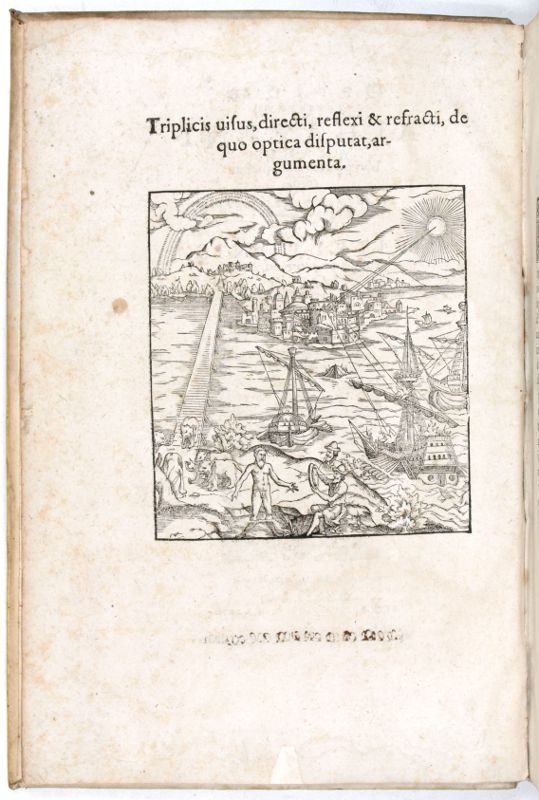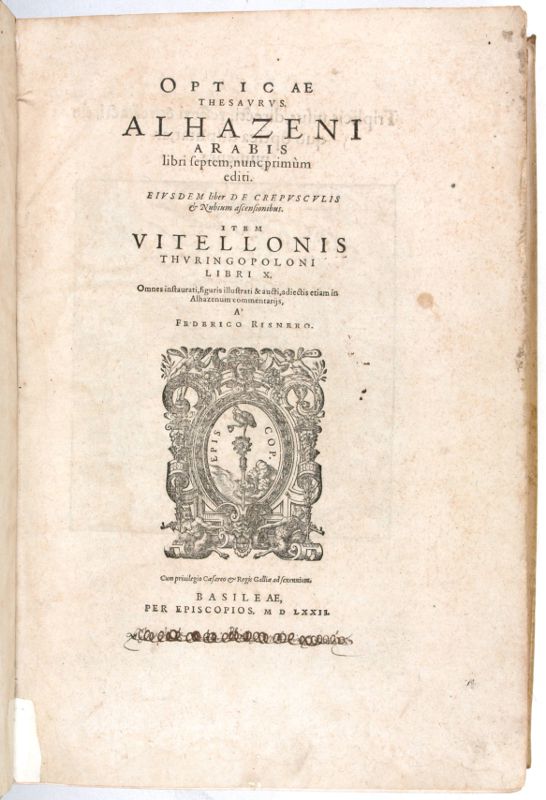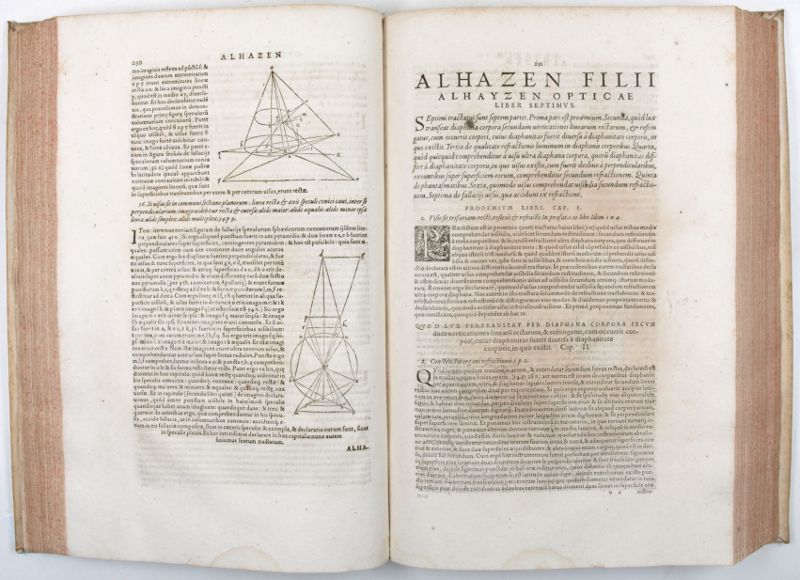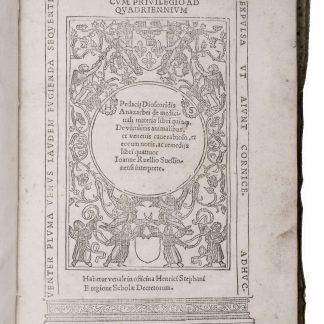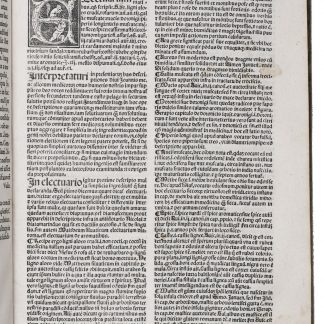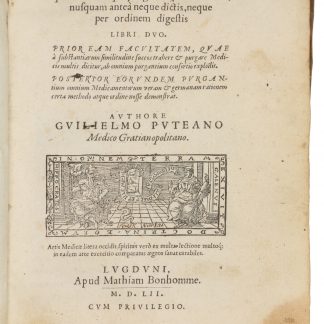[SOLD]
This item has sold. We are always interested in acquiring another copy or any item of comparable quality.
Alhazen’s optics: the exceedingly rare first edition of a milestone in Arabic science
[Kitab al-Manazir, latine]. Opticae thesaurus. Alhazeni Arabis libri septem, nunc primum editi. Eiusdem liber de crepusculis & Nubium ascensionibus. Item Vitellonis Thuringopoloni libri X [...]. (Ed. F. Risner).
Folio (248 x 350 mm). 2 parts in 1 vol. 1st blank f., (6), 288 pp. (8), 474, (2) pp. With 2 different woodcut printer's devices on t. p. and colophon, half-page woodcut on reverse of t. p. (repeated on half-title of pt. 2), and numerous diagrams in the text. Near-contemporary full vellum binding with giltstamped red spine label. All edges sprinkled in red.
First edition of "the most important work of its kind in Arabic literature" (cf. Poggendorf). Ibn al-Haytham (965-c. 1040), known as Alhazen in the Latin tradition, has been hailed as "the greatest Muslim physicist and one of the greatest students of optics of all times [...] The Latin translation [...] exerted a great influence upon Western science. It showed a great progress in experimental method. [Alhazen's book contains] research in catoptrics, [a] study of atmospheric refraction, [a] better description of the eye, and better understanding of vision [as well as an] attempt to explain binocular vision [and the] earliest use of the camera obscura" (Sarton). "This combined edition served as the standard reference work on optics well into the 17th century, influencing scientists such as Brahe, Kepler, Galileo, and Descartes" (Norman). "The Arab physicist Alhazen preserved for us all that was known by the ancients in the field of optics and added some contributions of his own. His book remained a standard authority thru the 1600s. He understood that light emanated spherically from a point and greatly improved on Ptolemy's uncertain rule for refraction which, he showed, held true only for small angles. He covered many cases of reflection and refraction and his explanation of the structure and function of the eye was followed for 600 years" (Dibner). "Ibn al-Haytham's Book of Optics is now a thousand years old. It revolutionized optics and had great impact on science in Europe, being cited by Roger Bacon and Johannes Kepler, among others" (AR, p. 99). "It is remarkable that in the Islamic world the 'Optics' practically disappeared from view soon after its appearance in the 11th century until, in the beginning of the 14th century, the Persian scholar Kamal al-Din composed his great critical commentary on it [...] By this time the 'Optics' had embarked on a new career in the West where it was already widely and avidly studied in a Latin translation of the late 12th or early 13th century, entitled 'Perspectiva' or 'De aspectibus' [...] The Latin translation was published by Frederick Risner at Basel in 1572 in a volume entitled 'Opticae thesaurus', which included Witelo's 'Perspectiva' [...] Risner's Latin edition made [the 'Optics'] available to such mathematicians as Kepler, Snell, Beeckman, Fermat, Harriot, and Descartes, all of whom except the last directly referred to Alhazen", though Descartes "employed [the work] in his successful deduction of the sine law" (DSB, p. 194-197). The 'Liber de crepusculis', the work on dawn and twilight included in Risner's 'Opticae thesaurus' and attributed to Alhazen, is actually the work of his contemporary Abu 'Abdallah Muhammad ibn Mu'adh al-Jayyani (cf. Norman; DSB, p. 208). The optical study by the Polish scholar Witelo, likewise here included, is "a massive work that relies extensively on Alhazen [and] offers an analysis of reflection that was not surpassed until the 17th century" (Norman).
Variously browned due to paper, but altogether quite a crisp, wide-margined copy, with an apparently contemporary handwritten ownership to the title page (deleted some time in the 17th or 18th century), a very few inconspicuous repairs to the edges, a faint waterstain to the lower margin and some slight worming to the lower gutter. Binding tight and well-preserved, with 17th or early 18th century library shelfmarks to front pastedown. An unusually fine specimen of a principal work of Arabic science as received in the West.
VD 16, H 693 (H 692, V 1761). Adams A 745. BM-STC 383. Dibner 138. Norman 1027. Honeyman I, 73. DSB VI, 205. GAL I, 470. Poggendorf I, 31. Duncan 113. Sarton I, 721. Carmody p. 140. Thorndike/Kibre 803, 1208. Vagnetti D62. BNHCat A 241. IA 103.705. Brunet I, 180. Arabick Roots Doha AR79.



